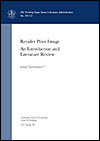This working paper aims to give an introduction to what we know about what makes up and influences the retailer’s price image: “the general belief about the overall level of prices that consumers associate with a particular retailer” (R. Hamilton & Chernev, 2013). What have been the main themes in academic price image research? The focus is on what relevant empirical evidence has been published and what conclusions can be drawn. We also provide some illustrative new empirical data.
Working paper
Retailer Price Image - An Introduction and Literature ReviewGunnarsson, J. (2015). SSE Working Paper Series in Business Administration. No 2015:2.
The paper is written as a first stop for academic researchers, students and retail practitioners interested in the area. Some important studies are therefore reported in more detail than usual.
The paper begins by discussing the background and relevance of the topic. We acknowledge the importance of pricing in the modern retailer’s strategic toolbox, but like many price researchers before us point out the many shortcomings of relying solely on actual prices and promotion in achieving long-term objectives such as brand associations to prices and value. We also stress the importance of understanding the specific challenges of the “retailer as a brand”, which we believe has an important and somewhat neglected impact on the modern management of price image.
We continue the first section by introducing a number of key theoretical concepts that are frequently used in the behavioral pricing and price image literature. We then conclude by discussing the crucial role of consumer memory and decision making biases in understanding how consumers process information about retailers, their stores and prices. These concepts and definitions are important to understand when reading the remainder of the paper.
The empirical section covers many of the issues which in different research streams have been found to be of relevance to understanding how consumers process price information and how they react to cues which retailers attempt to manage every day. These areas include:
- Store environment
- Assortment structure
- Price communication
- Price dispersion
- Pricing strategy
- Known value items
- Consumer strategies in forming price images from different cues
The consequences of choosing the strategy of engaging in a serious price war in order to strengthen a weak price image are discussed in a separate chapter mainly based on the Dutch price war of 2003- 2005. We also devote one chapter to discount retailers. These have been very successful in many markets – what can we learn from the way have they managed to protect their price image and what pitfalls are they facing in a world where they are increasingly forced to adopt distributor brands and introducing new value propositions into their customer offering?
We conclude the empirical section by discussing two somewhat neglected issues in price image research. The first involves how the retailer as a brand can serve as leverage in or obstacle to managing price image. The second focuses on the related issue of the challenges retailers face when attempting to change their price image position and how they can be met based on what we know from consumer and brand research.
We continue with a concluding section where we attempt to wrap up and visualize the research area with some proposed extensions based on framework proposed by Hamilton and Chernev (2013).
Finally we deliver some suggestions for a relevant research agenda. We believe that there are plenty of opportunities to increase research relevance by both updating and pushing forward in some research streams where empirical studies are outdated or scarce. There are also some exciting new research areas.
(texten är hämtad ur working papret)

